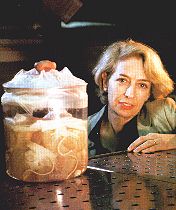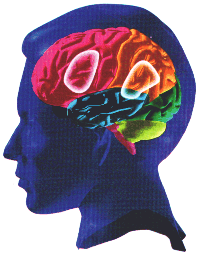Make your mind up
Reproduced from the

How do you get your head round the human brain?A new BBC2 series seeks to analyse what Dr Mark Porter calls the planet's most amazing piece of engineering.
 It's said that picture is worth a thousand words and after
watching Brain Story,
Professor
Susan Greenfield's six-part exploration of what
goes on inside our heads, I see no reason to disagree. One scene shows a
woman undergoing surgery to remove a brain tumour. She is lying on an operating
table separated from the surgeon by a vertical screen attached around her
hairline. She is conscious and talking. On the other side of the screen you
can see that the top of her skull has been removed and her exposed brain
is being prodded with electrodes to enable the surgical team to ascertain
which parts are responsible for speech, and avoid them during the ensuing
surgery.
It's said that picture is worth a thousand words and after
watching Brain Story,
Professor
Susan Greenfield's six-part exploration of what
goes on inside our heads, I see no reason to disagree. One scene shows a
woman undergoing surgery to remove a brain tumour. She is lying on an operating
table separated from the surgeon by a vertical screen attached around her
hairline. She is conscious and talking. On the other side of the screen you
can see that the top of her skull has been removed and her exposed brain
is being prodded with electrodes to enable the surgical team to ascertain
which parts are responsible for speech, and avoid them during the ensuing
surgery.
 |
| Is it true that genius is all in the mind? Susan Greenfield tries to find out by investigating the Brain Story |
So, while the person chats about her favourite recipes, we
see the part of her body responsible for the conversation, which - although
it looks like little more than a huge pickled walnut - contains her mind,
her memories and her personality. It's a surreal scene that reinforces just
how little we know about the human brain, the most amazing piece of engineering
on the planet.
It is all too easy to slip into hyperbole when describing the complexity
and capability of the human brain, but the facts speak for themselves. It
weighs just over a kilogram (around 2 1/2 lb), contains
more than 100 billion individual cells (neurones), has no moving parts and
is built from information contained in a single sperm and ovum. Our greatest
technological feats - Cray supercomputers, the cruise-missile navigation
system and Pentium chips, for example - pale into insignificance when compared
with the human brain, which takes multitasking to a new height and, most
importantly of all, is sentient.
Neuroscientists have made progress in recent years and now have a good basic
understanding of many of the brain's functions. We know each brain cell can
be connected to as many as several hundred others and they communicate via
dozens of different chemical messengers called neurotransmitters (the best
- known being dopamine, serotonin and noradrenaline). We know there are
specialised areas responsible for certain functions - the frontal lobe is
involved in determining temperament and personality and the basal ganglia
co-ordinate movement - but we don't know how the areas link up or what gives
the brain sentience.
Recent advances in scanning techniques have allowed researchers to watch
the brain in action and follow a single thought. what they have shown is
that the brain works as a collection of specialised modules that come together
in fractions of a second to perform even the simplest of tasks. What they
haven't revealed is how such seamless integration occurs or what higher brain
function controls it.
 |
| PARTS THAT MAKE THE WHOLE Different areas of the brain control different aspects of our lives: the cerebrum (the top pink, orange, dark green and blue areas) is responsible for, among its multiple functions, thought; language is controlled in the white area; the cerebellum (pale green) coordinates movement; and the brain stem (bottom pink) controls breathing. |
Much of our current understanding comes from observing people
who have lost functions as a result of brain damage. Brain Story features
a number of such cases, including a man whose frontal lobe is slowly degenerating
as a result of a rare form of dementia. The frontal lobe has an inhibitory
role on the rest of the brain; people with frontal lobe damage often behave
antisocially (a similar, temporary effect is seen with alcohol). But there
is an upside in the case followed by Brain Story - the man in question
suddenly discovers a talent for painting. It will probably only be temporary
and will disappear as his disease progresses, but it provides a clue to his
previously hidden capabilities - could we all carry similar skills locked
away in our brains?
Differing perceptions of our environment may also account for our individual
characters and skills. Artist Vincent
van Gogh's unique style, for instance, may well have been down to epilepsy.
Van Gogh could have had temporal lobe epilepsy and the resulting dysfunction
in that part of his brain may have meant that he saw the world differently
from the rest of us - the temporal lobe being responsible,
among other things, for perception of colours. Maybe he was just painting
what he saw.
Controversially, the programme even suggests that it is possible to
explain religious belief neurophysiologically.
The feeling that we are somehow separate from our bodies - the mind, soul
or spirit, call it what you will - is a natural repercussion of the brain's
sentience, but is it any more than that? Researchers have even managed to
create religious-type experiences using external temporal lobe stimulation
- subjects typically describe feeling as though they are travelling down
a tunnel towards a bright light and that they are not alone (the feeling
of a presence in the room is particularly well described).
The programme asks many questions, and doesn't answer many of them, but should
stimulate many a dinner-table debate. Now that the human genome has been
cracked, a proper understanding of the workings of the brain remains the
next great quest. Part of me hopes we never achieve it.
Dr Mark Porter co-presents
Watchdog Healthcheck Mondays
BBC1 and is on Jimmy Young, alternate Mondays Radio 2.